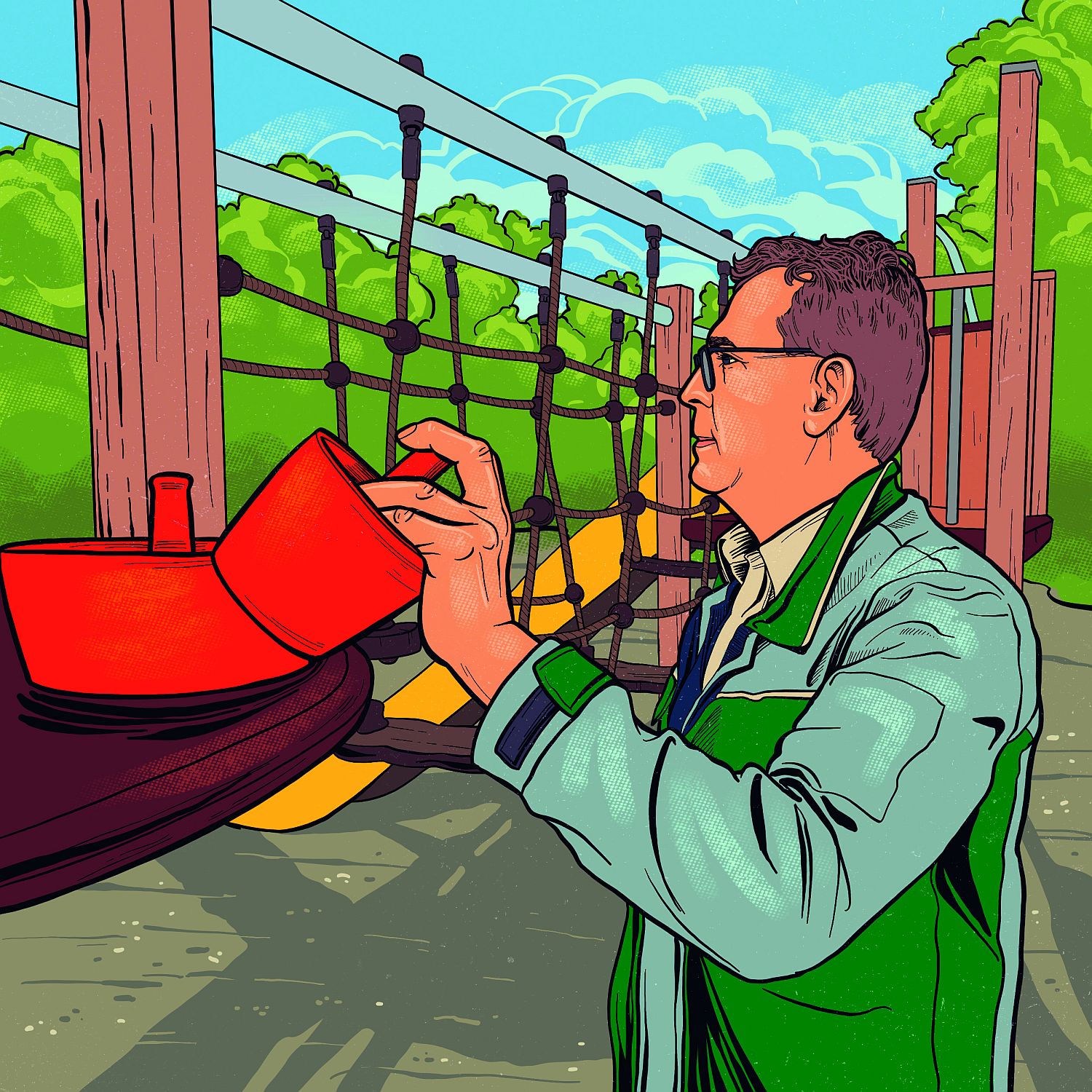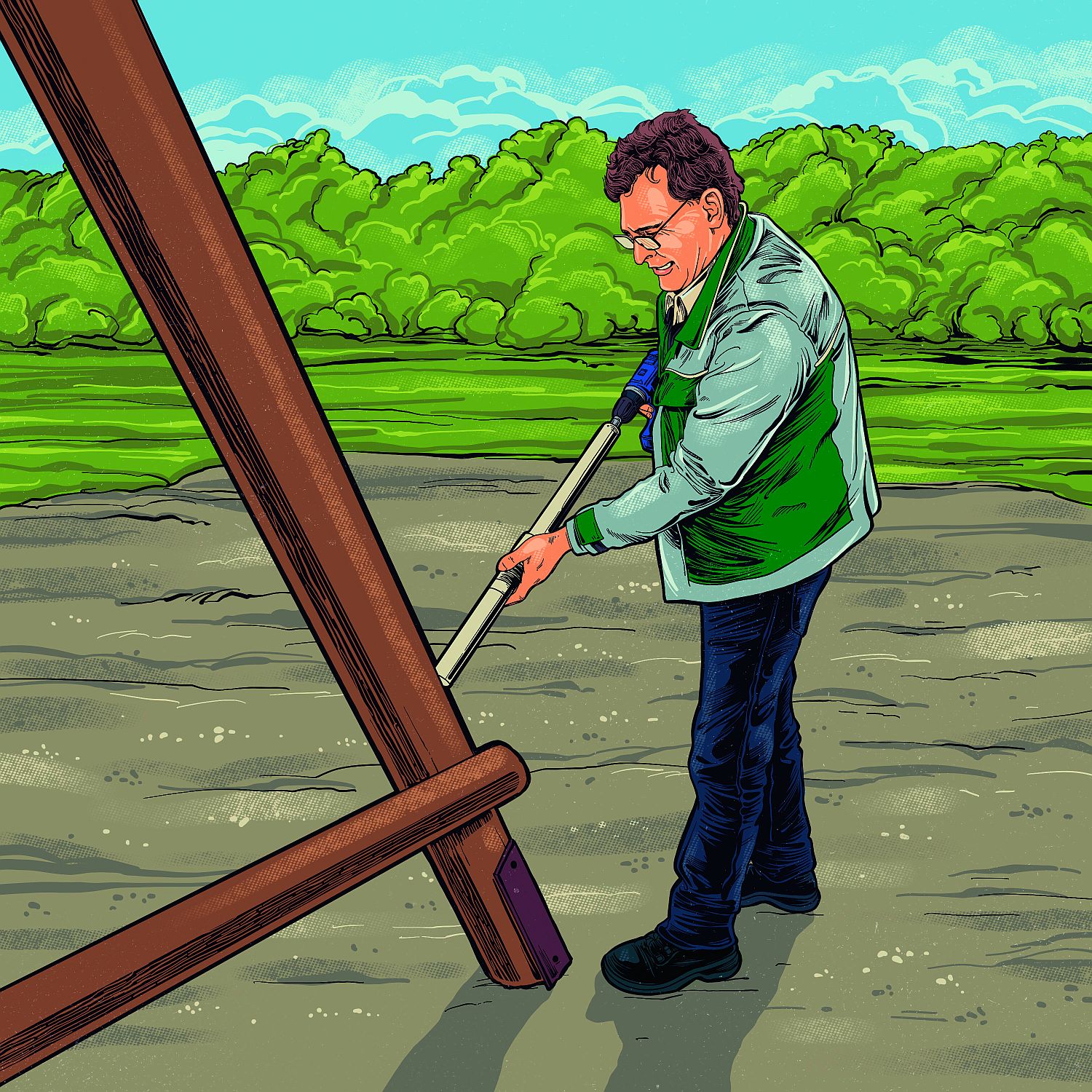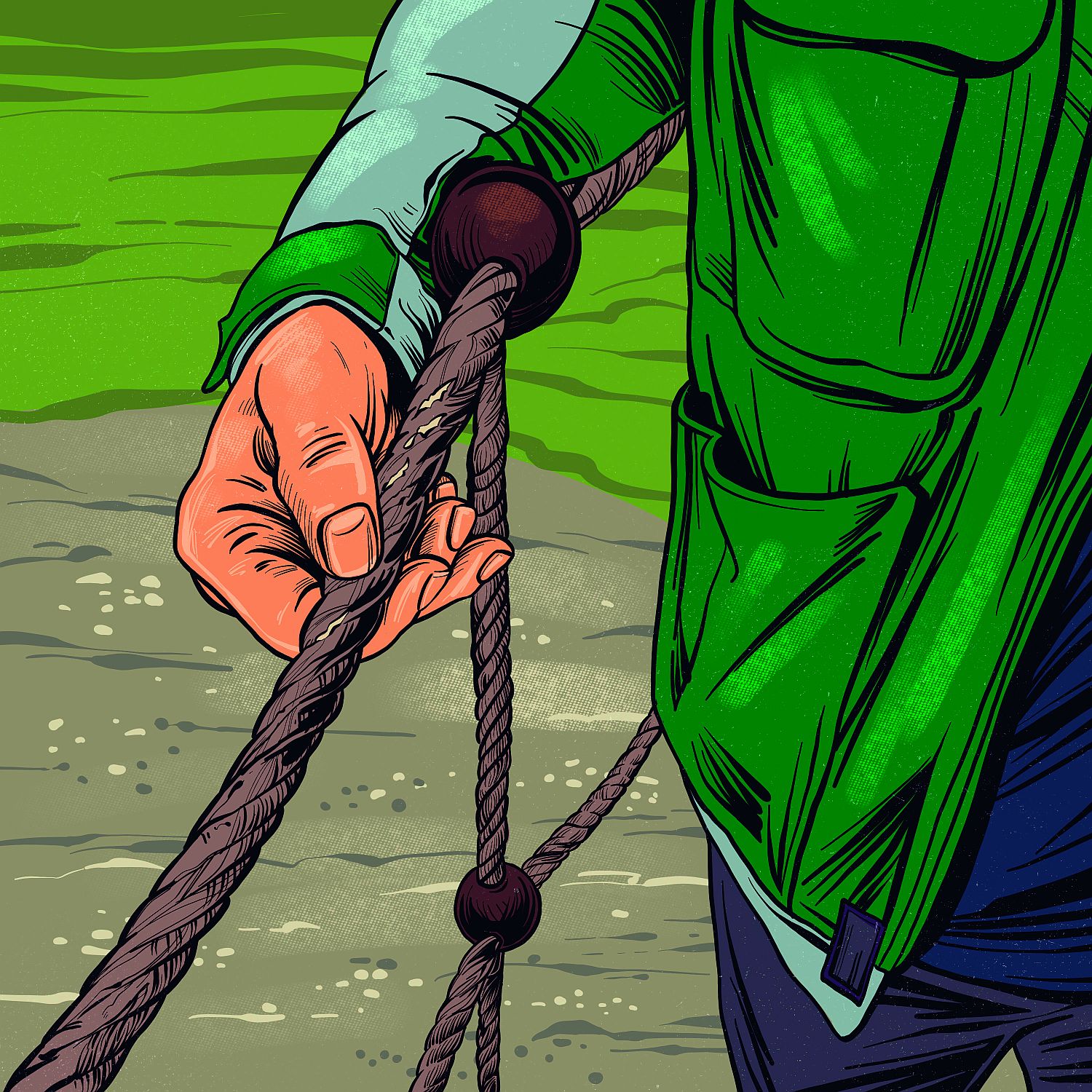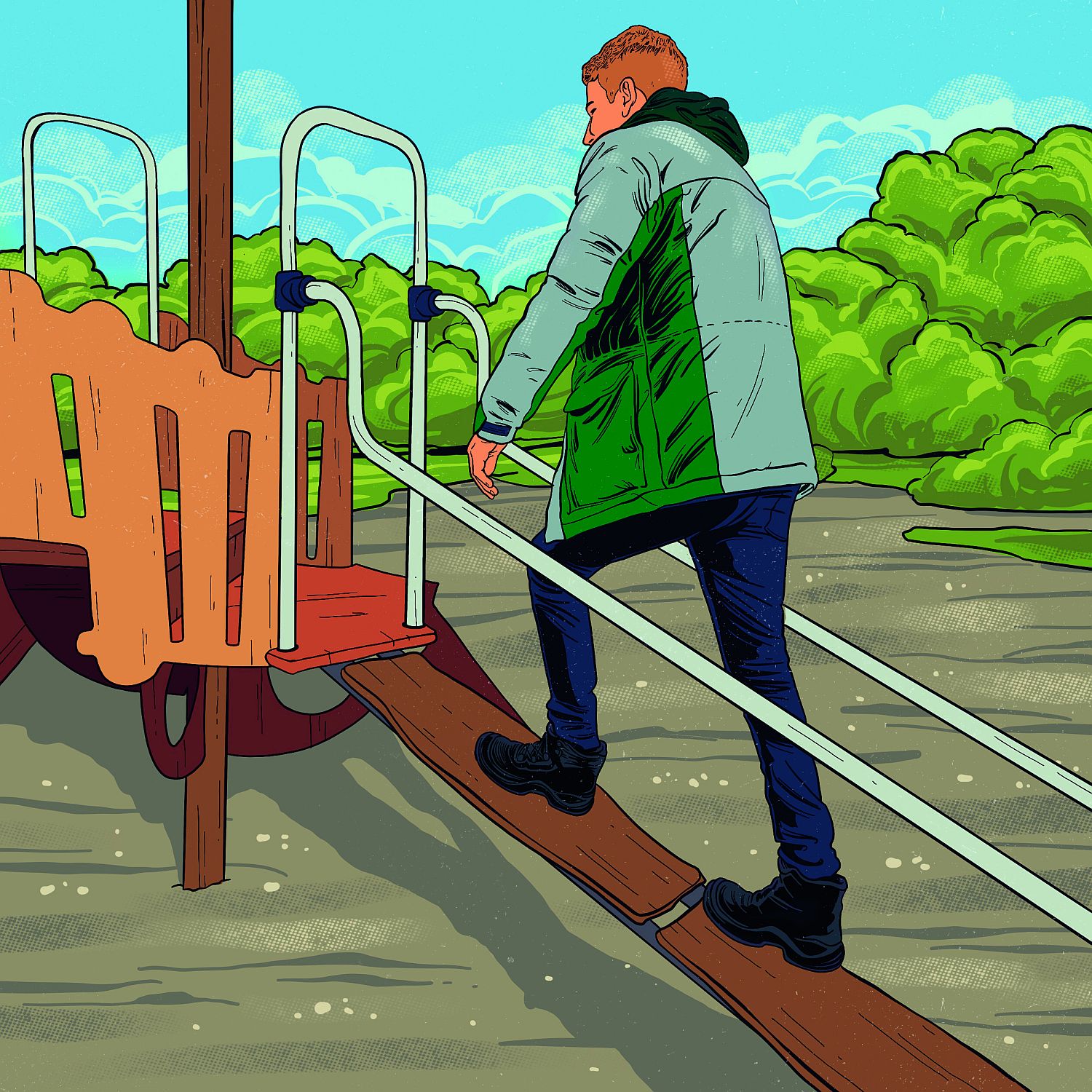With the License to Swing
Author: Jennifer Klein
The DEKRA playground testers are once again doing their rounds. Each spring, they commence their tour of Germany’s playgrounds and test the apparatus’ safety.
A grown man on a swing set? DEKRA playground testers Michael Brandt and his colleague Lars Steiger are used to receiving curious looks and questions from child and parent alike, including here, at the Franco-German garden in Saarbrücken. They take it all in their stride. Thanks to the logos on their uniforms, it is quickly apparent that the pair are on official business. They take slides, see-saws, jungle gyms and the like at playgrounds and recreational areas under the magnifying glass. Their mission? To find and eliminate all possible hazards.
Once the blue skies, sunshine and milder temperatures of spring begin to lure you back outdoors, it is high season for about 120 DEKRA experts. They tour Germany’s playgrounds to ensure everything is in order and any damage sustained during the winter is remedied. They manage to visit five or six play facilities every day. Clients mainly constitute local authorities, but also include private operators.
Each year, 16,000 playground accidents are reported. “Playgrounds, playground equipment and recreational facilities such as swimming pools are all subject to particularly stringent safety requirements,” explains Michael Brandt. The bar is set high as far as quality is concerned, and applies equally to manufacturers, operators and inspection staff. Michael Brandt is a DIN-certified DEKRA playground expert. To achieve this certification, a special training course is necessary – Lars Steiger is currently in the thick of it.
The first view goes down
Upon entering a playground, their first glance is often a downward one. The flooring also acts as fall protection, and the material must feature a certain grain size and filling level. This is checked by means of a measuring stick. At this playground, it reveals that the flooring does not reach the required level in all areas. In some spots, the ground has so little coverage, that after a quick scuff with the foot, the small pebbles are all but gone. “It needs to be topped up here,” explains Michael Brandt.
Following this, additional sources of hazard are examined. Where is there a fall risk? Are there pinch points? Sharp objects that may cause injury? What is the condition of the play equipment? Is the pitch of the slide still correct? Are there loose or uncovered screws? Worn ropes, rusted chains? Concentration, good observational skills and precision are all necessary. The surrounding environment, fences, climbable trees, potentially poisonous plants, and the paths to the playground are all examined in the inspection.
Safe, touch wood
“Beneath the seat of the swing, there must be at least 35 centimeters of ground clearance,” explains Brandt, while fetching the measuring tape from his rucksack. The clearance is correct. “You can also hear by the sound, whether the wood is in good condition,” he reports and performs the knocking test with a hammer. Next up is a special device with a fine needle for boring into wood. With this device, one can identify whether the wooden swing frame is rotting or decayed. By now, the two experts have the full attention of the children and their parents, who gradually edge closer. They get into a conversation – communication is also an important part of the job. “This board is wobbly, too,” a small girl tells helpfully contributes.


Brandt and Steiger examine the apparatus. Luckily, the all-clear is announced. The wobbly board is designed as such. “After all, playground equipment should also provide the opportunity to learn how to deal with risks appropriately,” Brandt points out. This is how children train their motor skills and their protective reflexes. Falling safely is something that needs to be learned. Who dares climb over the roof of the jungle gym? Who is the best at balancing, when three stand on the seesaw together? Testing boundaries is a part of life. However, it is necessary to prevent the possibility serious accidents that cause injury or permanent damage.
For this reason, all those parts subject to elevated stress are checked for wear and degradation. Frayed ropes and rusted chain links are indicative that parts need to be replaced. Depending on how poor their condition is, the DEKRA experts are able to close off certain playground equipment, or even the entire playground itself if the situation is that dire. Damages must be repaired in a very short time frame. If this isn’t possible, the apparatus must be disassembled and removed.
Keeping an eye on the kids
Parents are also able to contribute to the safety of their children. While their offspring are playing on slides and conquering jungle gyms, they must make sure not to get distracted and entranced by their mobile phone. Chains or cords on clothing can easily become nooses. As can bicycle helmets, which can get caught while climbing or playing and become a strangle risk.
Then Michael Brandt and Lars Steiger reveal the secret of the bright red plastic parts in the testers’ rucksack – ‘child size’ test devices. These are used to test nets, rung spacings and possible pinch points. A thin metal cord is used to check possible points in which the drawstrings of hooded sweaters may get caught.
For Brandt, his job is far more than just that. He finds himself unable to switch off his ‘x-ray vision’ for possible danger situations even in his private life and when on vacation. “It’s just part of me now,” he says with a laugh, pointing to the iron fence surrounding the playground. “These sharp burrs on the edges are just unacceptable.” He rubs his finger over them. Another note on the list of required improvements. After their deployment out in the fresh air, the playground testers return to the office. They must write a detailed report – including recommendations for action and requirements for the operator. And then the next job is already waiting.
Safety Through Sound Judgment
Playgrounds are permitted to feature a certain, limited amount of risk. That is the opinion of many experts around the globe, who see playgrounds as testing areas in which children are able to train their motor skills and defensive reflexes. At the famous Diana, Princess of Wales’ Memorial Playground on Bayswater Road in London, which receives over one million annual visitors, there is a sign informing parents that the hazards are intentional. In Australia too, there are standards for children’s play areas that reinforce the advantages of physical development, and don’t just identify possible hazards. That isn’t to say that play equipment isn’t constructed and installed with the goal of ensuring the best-possible safety. It is the individual’s usage that harbors risk, and follows the simple logic ‘more training, better safety.’




